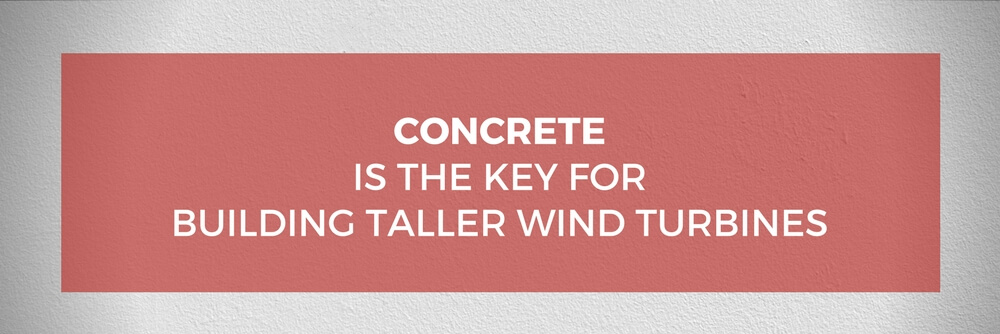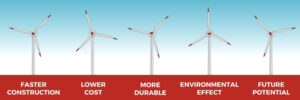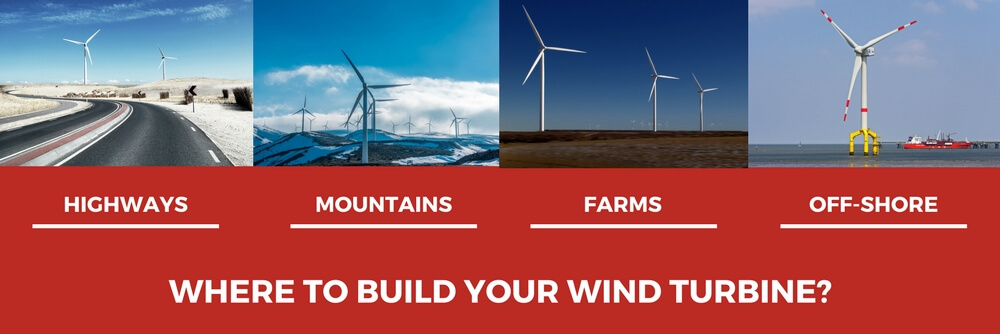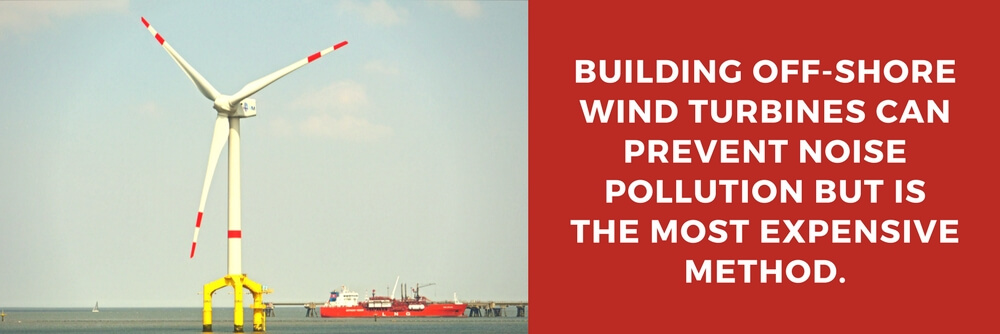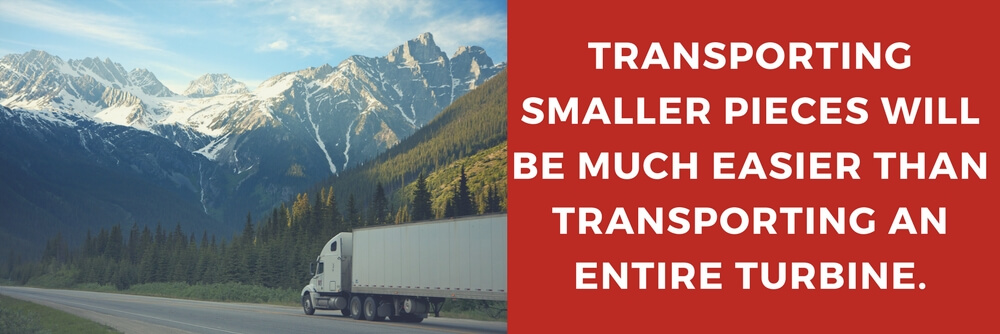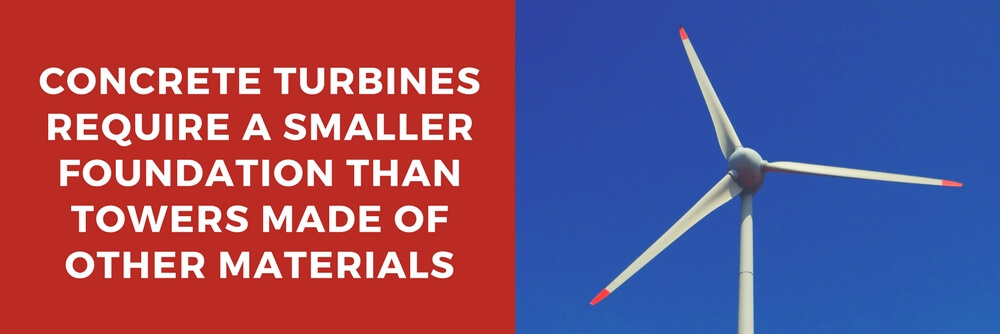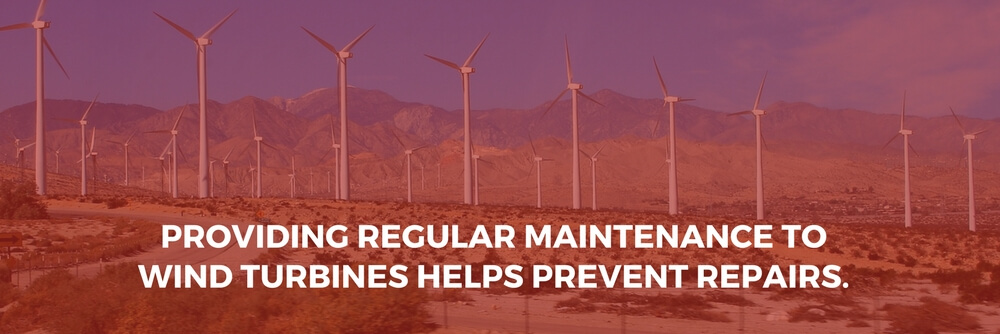USING CONCRETE FOR WIND TURBINES

Alternative energy is becoming more and more common in the United States and around the world. Fossil fuels such as coal and oil were once the only scalable sources of energy. Alternative energy options for renewable and clean energy include solar power, wind power, hydropower, geothermal power, nuclear power and biomass power.
With more and more changes occurring within the energy industry, you may be considering investing in alternative energy. These types of energy sources are well worth a closer look.
Wind energy is an increasingly popular choice as a form of alternative energy. This newer technology for collecting wind energy is always changing in order to make it better. One recent trend in wind energy is building taller wind turbines. However, steel is not the right material to use for these taller towers. It is better suited for shorter turbines. Concrete is the key to building taller wind turbines.
Taller wind turbines mean more energy is produced and the turbines last longer. Using concrete to build your wind turbine may be the best option.
THE ADVANTAGES OF USING CONCRETE
Concrete is not the most common material used for building wind turbines. Steel is used the most frequently, but that material has several drawbacks that concrete does not have. You can see here why concrete is a better material for building wind turbines:
- Faster construction: Building a wind tower using concrete is easier than using other material. Simpler assembly means the job will be done a lot quicker. It will also take less time to create the pieces needed to construct the tower.
- Lower cost during all phases of construction: In each step of the process of building a concrete wind turbine (outlined in greater detail below), you’ll save money. Creating the necessary pieces for the turbine and assembling it takes less time. That means you’ll have lower costs from labor and necessary equipment.
- Durability: A wind turbine made out of concrete will last much longer than a turbine made out of another material. Steel towers are expected to last between 20 and 25 years. Concrete towers can long outlast steel ones — they are estimated to last possibly up to 50 years. Concrete is much more resistant to erosion and other factors that could require maintenance and repairs. You’ll also save money with fewer repairs and maintenance requirements.
- Environmental effect: A big complaint against wind energy as an alternative energy source is the noise pollution. Many people who live near wind turbines don’t like doing so because of the extra noise. This is not as big of an issue with concrete. It has a dampening effect, which lessens the amount of noise the turbine makes.
- Future potential: A huge drawback of wind turbines made of steel is that they can only be built about 80 meters tall. Concrete doesn’t have this limitation. Wind turbines made of concrete are frequently built more than 100 meters, with some at 120 meters or higher. It’s also a possibility that concrete will be used more in other building projects, too. Mechanical engineers often have less experience with concrete, so that may explain why it hasn’t been used for wind turbines yet. Once these engineers experiment with it more as a material, it may improve wind turbines in other ways as well.
Choosing to build a wind turbine is a big decision, and it doesn’t come down to just that. There are many factors to consider and you must also understand the basic components of a turbine and the building process before you can even begin construction.
THE WIND TURBINE BUILDING PROCESS
Using concrete to build your wind turbine is more efficient and cost-effective. In order to successfully build a wind turbine, you have to successfully follow the process. Here are the steps to building a concrete wind turbine:
- Choosing where to build
- Building the pieces
- Transportation
- Construction
- What happens after the tower is completed
It’s important to put a lot of time and detail into your building plan. You don’t want to get started and then come across issues that delay the process.
CHOOSING WHERE TO BUILD
There are several common locations for building wind turbines. There are pros and cons to each location, so it’s important to evaluate which is the best location for your needs:
- Farms: The pros of building turbines on a farm are that it would require little to no landscaping because the location is likely already flat. Farms are typically in rural areas, so there is plenty of room to build multiple turbines. Building a wind turbine could also bring more jobs to those rural communities in constructing the turbines and then maintaining them. The cons include losing that land for farming and the potential of permanently affecting the quality of the soil if the turbines were later removed. Wind turbines also produce a lot of noise, which can scare farmers’ livestock.
- Mountains: Pros of constructing turbines in the mountains are that mountains create corridors of air movement which allow the turbines to produce more energy than in flat areas. Wind speed is higher at higher elevations. The cons include the difficulty of building in the terrain and having to space turbines farther apart. The terrain is the especially difficult part. The trucks transporting the parts for the turbine may have difficulties on mountain roads. Building turbines aren’t just about the turbine, either — you also need space on the mountain for other equipment and power lines.
- Highways: The pros of building turbines by highways are similar to building on farmland. The area around highways has, in most cases, already been developed. The land would not need many changes to accommodate the turbine. Another positive of building your turbine near highways is that the area around highways usually are not used for residential development because people don’t want to live right by them. Depending on the area, the land may be less expensive to buy, cutting down that cost. For stretches of highway with few exits, there usually isn’t much development nearby. It would be good to use that empty land for something, but using it as an energy source would be even better.
- Off-shore: The pros of constructing offshore wind turbines are that there is more wind off-shore and there is less sound pollution. Some people also view turbines as eyesores, so having them off-shore fixes that issue, too. The negative of building offshore turbines is that it is the most expensive method. The cost doesn’t just include building the turbine but also connecting the turbine to a power grid. Offshore wind turbines also disrupt fishing, boat navigation, ocean habitats and marine life.
When choosing a location for your turbine or turbines, it’s important to consider all of these factors. Your location will most likely come down to your budget and which location would begin positively returning on the investment.
BUILDING THE PIECES
After you’ve selected the location for your turbine, you can decide what type of tower to build. If you’re planning on building a smaller tower, steel is one option. However, if you want to build a taller tower, concrete is the material to use. You could also use a steel-concrete hybrid in some cases. A team at the Institute of Structural Engineering at TU Wien created a method for constructing taller wind turbines using concrete.
At a different site than where the tower will be constructed, you create the pieces for the tower. These pieces could be either round and solid or rectangular and hollow. The number of pieces you make depends on how tall the tower will be.
You also must decide how to make the blades for the turbine. The blades are often made from fiber-reinforced polymers.
During this phase, make sure you are making all of the parts of the turbine. If you can’t make all the parts yourself, contract another company. You don’t want to begin construction on the turbine only to realize you don’t have an important piece. If this happens, you’ll lose a lot of money with added labor costs and possible costs to expedite getting the missing pieces created and transported to the site quickly.
TRANSPORTATION
The next step in the process is getting the pieces to the construction site. Unlike using steel or other materials, the turbine will not be transported all in one piece. It will be in smaller pieces that will be assembled on the site. Transporting these smaller pieces will be much easier than transporting an entire turbine. Additionally, laws state that the tallest turbine that can be transported in one piece is 80 meters.
The location of your turbine will also affect transportation. If you selected a mountain location, there may be extra standards and requirements for hauling on those types of roads. Even if you selected a flatter terrain, such as on a farm, you must understand the route from the assembly location to the construction location. Roads in rural areas may be difficult to transport the pieces. These roads are often narrow with hills and sharp turns. Planning ahead so you can anticipate any transportation difficulties will help you in the long run.
If you are transporting a taller tower, it should still have similar transportation costs compared to a smaller tower made of steel.
CONSTRUCTION
Building the tower will make up the majority of this process. The construction process isn’t just about assembling the turbine, either — there are many other necessary elements that make the turbine work. Constructing a concrete wind turbine is different compared to other types of turbines.
First, you build the foundation of the tower. If the foundation is not built properly, it could compromise the structural integrity of the entire tower. Building wind turbines out of concrete actually requires a smaller foundation than towers made of other materials. Using concrete means the tower will be much heavier and it will also be more stable. The foundation of the tower will be less expensive to build and take less time than if you were building a tower out of a different material.
After the foundation is complete, you begin building the actual tower. If you used the method of solid pieces, you put them together like building blocks and reinforce the connections. If you used the method with the hollow pieces, you will do the same thing but then pour more concrete into the hollow inside. These methods mean the tower will come together quickly.
Wind turbines typically follow similar designs no matter the material. The pieces that make up the tower are made of different thicknesses depending on where they are in the tower. Pieces at the bottom will be the thickest, while the pieces at the top will be the least thick. The tower is designed this way so it can withstand the high winds it needs to produce the most energy.
Using concrete means your foundation and tower will be built quicker. This helps reduce costs because you need laborers for less time and your turbine could be up and running more quickly.
After the foundation and tower are finished, you must build the remaining elements. The blades must be constructed and assembled on the tower. The blades will attach to a rotor that connects to a generator. The generator must then be connected to a power grid to distribute the created electricity. You may also want to build equipment that can store electricity. If there comes a time where there isn’t enough wind, your turbine will not be able to create as much energy. Storing electricity when the turbine is creating more than expected can help offset the periods when it makes less energy. This will help you have a turbine that can give off a more steady and predictable amount of energy.
Once your turbine is up and running, you only have to worry about smaller things.
WHAT HAPPENS NEXT?
Even though your concrete wind turbine is finished, it doesn’t mean the job is over. You still have to routinely maintain it, fix anything that breaks and plan ahead in case you ever have to demolish it.
Concrete wind turbines are the less common form of wind turbines, at least for now. This means you will have a different way of maintaining it. Additionally, a larger turbine actually means you will have a lower cost to operate it.
MAINTENANCE AND REPAIRS
Wind turbines are very expensive pieces of machinery, so it’s important to continue maintaining it so it lasts as long as possible. Providing regular maintenance helps prevent repairs.
Regularly lubricating the turbine and other parts is one key to maintaining the turbine. Different parts need different lubricants, so make sure you know which oils to use where and how often to use them.
There are companies that you can contract to do maintenance on the turbines.
Your turbines’ maintenance will also vary depending on the location you chose to build. An off-shore turbine may need extra maintenance because it is constantly assaulted by water and other oceanic elements. A turbine near a highway in the Midwest may need maintenance to get rid of dirt and dust frequently. Once you’ve finished building your turbine — or even before you begin building — you need to come up with a maintenance plan.
Figure out exactly what maintenance your turbine needs and how often it needs it. It’s also very important to figure out if the turbine needs any special or unique maintenance needs.
Even with regular maintenance, your turbine will likely need repairs at some point. It’s important to address repairs quickly and efficiently, because while your turbine is broken, it cannot produce any energy. A repair may be needed if a storm in the area damages a part or parts of the turbine. Or, a piece of the machinery may need to be replaced.
Repairs could potentially be needed for mechanical and electrical parts of the turbine. Like the maintenance needs, there are companies that specialize in repairing wind turbine parts.
DEMOLITION
This won’t be an issue anytime soon, but it’s important to remember that you may one day have to demolish your turbine. This may happen if your turbine became damaged beyond reasonable repair or its maintenance costs become greater than the profit from the energy it produces. If this becomes a reality down the road, you may not lose your entire investment. Concrete again proves itself in this scenario.
You will likely be able to salvage the concrete from the tower. Concrete from demolished buildings was once disposed of in landfills, but recent years have seen that concrete being recycled. If you have other projects where you need concrete or other things made from it, you could use it yourself. You may also be able to sell it. However, you could potentially have your turbine working for 50 years, and there could be even more uses for recycled concrete at that point.
LEARN MORE ABOUT OUR CONSTRUCTION SERVICES
Choosing to build a concrete wind turbine or turbines will be a big project. As long as you plan ahead, anticipate as many problems that could occur as you can, and regularly maintain your turbines, you could benefit from the clean energy for many years.
R.J. Potteiger Construction Services, Inc. has a number of concrete services for these and many other applications. Contact us today or call our office at 717-528-2782 for any of your concrete needs in Central PA.




